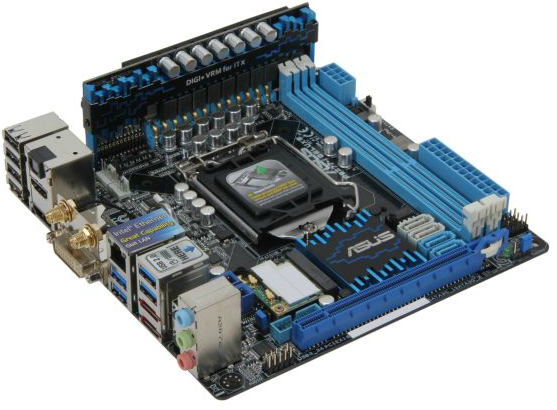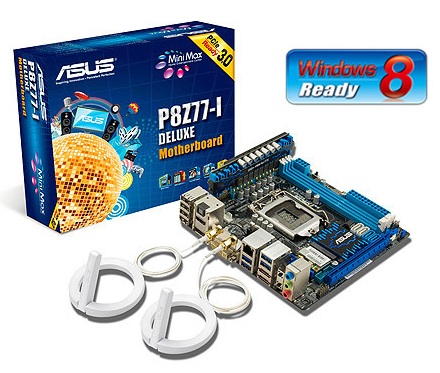Z77 mITX Round-Up: Five of the Best – MSI, Zotac, ASRock, EVGA and ASUS
by Ian Cutress on December 31, 2012 7:00 AM EST- Posted in
- Motherboards
- MSI
- ASRock
- EVGA
- ZOTAC
- Asus
- Ivy Bridge
- Z77
- mITX
ASUS P8Z77-I Deluxe Conclusion
In an industry that is losing overall sales globally and no new markets opening up, gaining market share involves taking it from your competitors. One way of doing that is by undercutting the competition, which reduces profit margins and generates a race to the bottom. The other is by innovation, but again it is hard to innovate if that occurs at great cost and there is no return in a shrinking market.
Nevertheless, ASUS has innovated. On the P8Z77-I Deluxe, the most striking feature is the motherboard layout which uses a daughter board to provide the power delivery. Using this extra z-height PCB gives extra space on the main PCB for functionality, at the downside of restricting the motherboard usage is some very-low profile cases. One of ASUS’ raison d’être is to provide a customer with something no other manufacturer can provide, and options like the TPU and USB BIOS Flashback are part of that equation.

The ASUS P8Z77-I Deluxe gives us, inter alia, a regular socket arrangement, a nicely placed 8-pin power connector, onboard WiFi (or WiDi with the corresponding model) with a pair of magnetic ring antenna, options for all four of the main video outputs, a total of eight USB ports on the IO panel (four USB 3.0), a total of six USB 3.0 ports altogether, a pair of fan headers with top-of-the-line fan controls and a pair of eSATA 3 Gbps on the back panel. This goes on top of a rock solid BIOS and software package.
There are a few issues worth mentioning, such as the positioning of the front panel audio header which will be blocked by a big GPU unless the z-height of the connector is minimal. Also there is no mSATA like on some other boards, and the SATA arrangement would require all the locking SATA cables being removed if the one at the bottom needs changing. If a GPU with a backplate is used, it could also obstruct the USB 3.0 port. On a more personal (and system debugger) note, I would have liked to see a two-digit debug as well.

Performance from the ASUS ranks among the highest, with one test pulling out a repetitive 5-20% lead over the rest. Among the gaming benchmarks it also scores very highly in the face of the competition. Power draw on our test bed was qualitatively lower, and Windows 7 POST times sat around the 11 second mark with a discrete GPU installed.
Honestly, if I were constructing a mITX build today, out of the boards tested, it would easily be with the ASUS P8Z77-I Deluxe. It comes in at $185 for the normal version and $200 for the WiDi version, which may be pricey compared to the others tested in this review, but in return we have a solid package that is easy to use and well featured. There may be a different winner if you look at price/performance in the strictest sense, but having the ASUS on the test bed and using it for my testing brought a fuller sense of ease in mITX computing.
As a result, I would like to give the ASUS P8Z77-I Deluxe an AnandTech Editors’ Choice Bronze Award, for a combined effort in motherboard innovation and as an overall package.

ASUS P8Z77-I Deluxe
AnandTech Editors’ Choice Bronze Award










54 Comments
View All Comments
ryedizzel - Monday, December 31, 2012 - link
Thank you so much for this Z77 roundup as I'm currently shopping for a new mobo and have been piecing together reviews from various sites. But as usual I always check here first, then Tom's, then Hardocp (in that order). Keep up the great work in 2013!Aikouka - Monday, December 31, 2012 - link
Ah, if only I held off on building my silent HTPC for a little bit longer. The hardest part about working with a Streacom case (other than building it) is finding a good motherboard that doesn't put too much in the way of the heat pipes. That's one reason why I was considering going with a board with mSATA, and I'm pretty certain that I stumbled across that ASRock board. Unfortunately, I looked at the photos, and didn't see a mSATA port, so I passed on it. Who would have thought to look at the back? Boy, do I feel like a bit of a dummy now! =$Although, speaking of the back mSATA connector, I recall seeing you touch on it on the recommendation page, but do you think it would work well on most cases? If I remember correctly, mSATA drives are fairly thin, so it might be fine. Going back to the Streacom, it does look like the ASRock offering would work well in regard to clearance even disregarding the mSATA port as the light gray SATA ports should clear the heat pipes. The USB3 port won't though.
philipma1957 - Monday, December 31, 2012 - link
I built 2 asrock builds with the msata as the only drive. btw this z77 review with no regard to oc is pretty weird.I have a 3770k with a hd7970 gpu and an msata in a small case the cooler master elite it is a very fast powerful machine. I use the asrock and love it. it does have a flaw the msata slot is sata II
Ananke - Monday, December 31, 2012 - link
I have i3-3225 (the same as in the article). In my opinion, for the money, the best is ASUS P8H77-I.It does have 6 SATA ports - a must for a file server. So, basically install Windows 8 on a SSD, add HDDs and create Storage Space - 5 SATA will allow you to create software RAID 5, without the need of SATA extension controller. BIOS is nice and stable. The board is $100 on Newegg.
The ASUS Z77 Deluxe is nice, if anybody needs all the additional functionality in a small form factor. However, only 4 SATA - means no good for video, file, backup server. You get the "overclocking" ability though. I doubt how practical is overclocking into so small space, probably to a handful of people. Teh board costs $185.
So, I would say $100 is better than $185, plus you get all the 6 SATA ports - priceless.
DarkStryke - Monday, December 31, 2012 - link
Not everyone who games wants to have a huge tower. I've built more then one system based around the silverstone FT03-mini that runs a 3750k / Z77 deluxe-i and a GTX 670.I bring mine to lan parties and people are amazed at the power in such a small box, and it's just as fast as any desktop single GPU alternative.
Ananke - Monday, December 31, 2012 - link
ASUS P8H77-I is a mini ITX board - the cheaper variant of the reviewed deluxe board. It costs $100.ggathagan - Wednesday, January 2, 2013 - link
I agree; the H77 makes much more sense for most ITX builds.I built a system with the P8H77-I, a GTX670 and the FT03-MINI.
I don't think the daughter card of the Z77 Deluxe would have fit in the case.
tramways - Monday, December 31, 2012 - link
I registered here because the reviewer is lamenting that some boards use the ALC889 instead of the ALC892 codecs.The 889 like the 882 before it and the 898 after it is a much better codec than the 892.
The 883,888,892 codecs are the cheaper low performance DAC/ADC chips.
I would buy a board with the ALC889 or preferably the ALC898,but not with the ALC892.
all the best in 2013
Paul
limki - Monday, December 31, 2012 - link
too bad I already ordered mine last week ... MSI Z77IAto tell the truth, i don't really mind [ at 136€ its a bit pricier than asrock with my supplier]
the conclusion for this board seems a bit biased to me
but hey, if you're not looking for a tiny powerhouse, you don't need z77
- in SUGO 05(and most small cases), MB is horizontally and PSU is above it, so cables and airflow will always be nasty
- using a discrete GPU, you don't care about not having DVI or DP
- no additional controller (USB/SATA) -> I don't plan on using more than 2(won't fit into case), so why bother?
//btw is the SATA 6/3/m correct 2+2? shouldn't be also 2+2+1?
- and if I'm to take the "military grade" stuff at least half seriously, ...
EnzoFX - Monday, December 31, 2012 - link
Do the post times include those pesky AHCI driver loading screen? I hate that it adds so much more to the boot process.